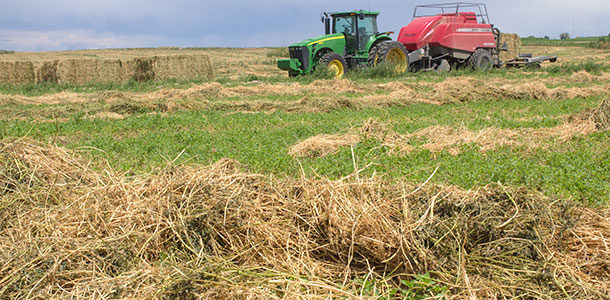Rain and poor drying conditions cause loss in hay in many ways:
- Soluble carbohydrates and other nutrients are leached out of the hay.
- Leaves shatter and are lost by direct impact of rain drops or from the increased mechanical agitation needed to dry the hay.
- Slow drying or rewetting prolongs plant respiration that lowers the energy content of the hay.
- Increased microbial activity further reduces nutrient concentration and amount.
- Slow drying windrows smother or slow growth of plants underneath.
- Additional equipment traffic, often on moist soil, to repeatedly turn hay increases soil compaction and plant damage.
- Delayed cutting results in harvesting more mature forage.
- Color bleaching increases.
- Heat damage occurs when forage is harvested at an improper moisture content.
- Animal acceptance and intake may decline.
How much is lost is difficult to estimate or even measure. Both forage yield and quality decline with weather-related losses. Dry matter yield losses can reach 100 percent when persistent rainfall results in a crop that can’t be removed or is chopped and returned to the field as mulch. Less extreme conditions produce highly variable losses. Factors affecting losses include timing, amount and duration of the rain, the species of hay, dryness of the crop when rain occurs and drying conditions after the rain.
Research on the impact of rainfall on cut alfalfa or grass under specific conditions has found that the amount of loss is highly variable and difficult to predict. Michigan studies showed that dry matter losses were higher when a specific amount of total simulated rainfall was spread over a longer time period.
Losses from a heavy swath were as low as 5.5 percent when 0.7 inch of rain was applied over one hour, but the losses increased to 12.1 percent when the same 0.7 inch was applied over a seven-hour time period. Similarly, losses from nearly 2 inches of simulated rainfall over three hours went up from 6.5 percent to 10.6 percent as the cut crop dried from 65 to 25 percent moisture.
Earlier Wisconsin studies on alfalfa experienced substantially greater amounts of dry matter loss, but trends were similar to the Michigan results, with losses increasing as duration and amount of rainfall increased; 1 inch of rain one day after cutting caused a 22 percent loss in dry matter yield, and 1.6 inches over several days produced a 44 percent loss.
The large magnitude differences between the Michigan and Wisconsin research apparently resulted from large differences in the amount of leaf loss in the two studies. Leaf loss in Michigan never exceeded 4.2 percent, while leaf loss ranged from 8 to more than 20 percent in Wisconsin.
Arkansas research using a rainfall simulator on orchardgrass showed similar trends as alfalfa to crop dryness at the time of rain and to the amount of rainfall. When forage was still wet (67.4 percent moisture), losses from as much as 3 inches of rainfall were less than 2 percent. When the orchardgrass was dry enough to bale (15.3 percent moisture) or drier (4.1 percent moisture), losses exceeded 8 percent with 2 or more inches of rain.
While loss of dry matter yield is important, the loss of valuable nutrients usually is more serious. Most of the dry matter loss comes from readily soluble nutrients, especially soluble carbohydrates such as sugars. These carbohydrates are lost as a result of leaching by rainfall and by consumption via respiration of the plant tissue and by microbes.
Crude protein concentration, though, tends to change very little unless overall losses are great. While actual amount of crude protein declines, the reduction usually is proportional to the loss of total dry matter.
For example, the digestibility of alfalfa from the Wisconsin research described earlier declined from 72.7 percent when it experienced no rain to 57.2 percent following receipt of 1.6 inches of rain over several days. Crude protein only declined from 26.3 to 24.6 percent.
Losses experienced by rained-on hay are significant, variable and unpredictable. Minimizing these losses is critical for long-term, hay-making success. FG
Bruce Anderson is an extension forage specialist with the University of Nebraska – Lincoln. Email Bruce Anderson.
PHOTO: Dry matter loss is only one problem with rained-on hay. Valuable nutrients are lost as well. Photo by Lynn Jaynes.










